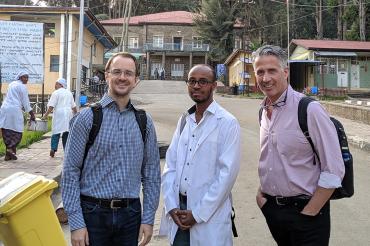U of T oral and maxillofacial surgeons save lives while training future doctors in Ethiopia

Published: January 8, 2020
Inside St. Peter's Specialized Hospital in Addis Ababa, patients lined the halls with ailments including head and neck tumours, kerosene burns, cleft lips and hyena bites.
They were waiting to be assessed by the first group of maxillofacial surgery residents at Addis Ababa University – and by a trio of oral and maxillofacial surgeons from the University of Toronto’s Faculty of Dentistry.
The U of T group took part in the first shared initiative between the Toronto Addis Ababa Academic Collaboration (TAAAC) and the surgical non-profit, Face the Future, which was founded by Canadian surgeon Dr. Peter Adamson. TAAAC is a partnership between U of T and Addis Ababa University that aims to promote academic training, teaching support and research collaboration in many different fields, including dentistry.
The universities and Face the Future had shared goals: to provide ongoing training for residents of the newly formed maxillofacial surgery program and to treat complex cases.
Faculty of Dentistry Assistant Professor Marco Caminiti gave lectures during the two-week stay while the AAU residents and attending surgeons received specialized hands-on training and worked alongside their U of T colleagues.
“The planning, surgeries and post-operative procedures were our way of training the residents in the essential practical skills they need,” said Caminiti, who is also the graduate specialty program director in oral and maxillofacial surgery at U of T.
Over the course of their visit, the team, which included U of T Assistant Professor Karl Cuddy and graduate resident Michael Laschuk, operated on dozens of patients and assessed many more.
The team faced challenges that included a lack of critical resources and surgical tools to language barriers.
Sometimes the surgeries were high-risk, complex procedures that lasted a full day. One such operation involved a total maxillectomy, requiring the removal of a patient's jaw, part of the nose and skin to cut out a large tumour.
Caminiti remains in touch with Dr. Demerew, his AAU colleague and director of the Addis Ababa University oral surgery program, via WhatsApp. “The relationships we forged there are very strong,” Caminiti says.
While the Addis Ababa maxillofacial surgery residents improved their core knowledge and surgical techniques, they weren’t the only ones to gain from the exchange.
“It was very humbling,” Cuddy says of his first trip to Addis Ababa. “I learned a lot about how to deal with resource limitations and challenges that we face on a completely different scale.”
Both Cuddy and Caminiti plan to return to Ethiopia for another teaching opportunity. Next time, though, they don’t want to arrive empty-handed. They want to put the word out that they’re looking for donations of specialized surgical equipment such as surgical drills, saws and facial plating systems.
“For every person we helped, there were five or six we wished we could have,” says Caminiti.
Next spring, when the first cohort of the maxillofacial surgery program graduates – only the second such program to be established in the country of 109 million people – their colleagues and friends in Canada will be cheering for them.
“It’s a wonderful collaboration between our two universities,” Cuddy says. “We have a lot to offer and we’ve really just scratched the surface.”



